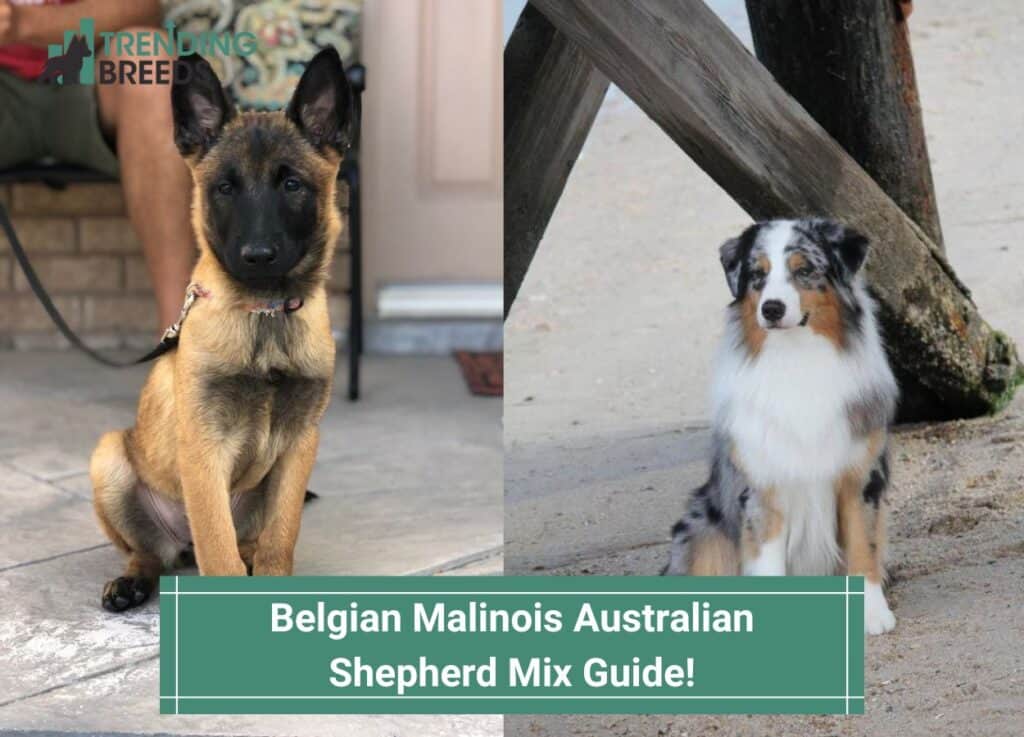
The Belgian Malinois Australian Shepherd mix makes a wonderful family pet. People of all ages enjoy their intelligence, activity, and loyalty, traits that make these dogs wonderful companions. Before you bring one of these dogs home, make sure you are prepared to devote time and energy to caring for one.
Don’t miss out on this great mix of Belgian Malinois and German shepherds! Here’s everything you need to know about this mix breed.
Other articles you would like: Tail Docking Australian Shepherds and Are Belgian Malinois Good Family Dogs?
Table of Contents
History Of The Mix

Since the Belgian Malinois Australian Shepherd mix is relatively new, there aren’t many historical records. Due to their documented origins, German Shepherd dogs and Belgian Malinois are considered breeds of dogs.
Around the turn of the century, Belgian Sheepdogs developed into four types, and the Belgian Malinois was one of these types. In addition to its short mahogany coat, the Belgian Sheepdog is primarily known for its black mask. It was first used as a shedding dog or a military dog.
Germany originated the German Shepherd breed, which was first developed in 1899. The German Shepherd was originally developed as a herding dog for sheep, and today it is one of the most popular breeds of dogs.
The reason for their popularity is no longer their herding abilities but rather their abilities as companions and guardians. According to the AKC, it ranks fourth in popularity.
There are similarities between the Belgian Malinois and German Shepherd regarding shepherding. This mix can be used both as a designer dog and a herding dog.
There might not be a better herding breed than the Belgian Malinois Australian Shepherd mix! This working dog is the offspring of two of the best.
Appearance

Belgian Malinois Australian Shepherd mix pups are a cross between a Belgian Malinois and an Australian Shepherd. Both German Shepherds and Belgian Malinois have striking similarities in their appearance. Therefore, Malinois Xs may be difficult to distinguish from their parent breeds.
The German Malinois is characterized by its flat skull, slightly long muzzle, and black nose. It has a beautiful face with deep, dark brown eyes that look like almonds.
There are multiple colors to choose from when it comes to the coat of the Malinois X. Like the German Shepherd and Belgian Malinois, it may have a black or brown coat, in addition to a blue or tan coat, fawn coat, or white coat.
Medium-length, coarse, rough, and shedding coats are typical of Malinois Shepherd mixes. German Shepherds can also inherit short coats from their parents.
There is a handsome and confident look about the German Malinois. Guard or service dogs need the sense of authority that German Shepherd Malinois mixes possess.
This beautiful mix of Belgian Malinois and German Shepherds combines the best features of both breeds. Their height varies from 22 to 26 inches, and they weigh anywhere from 40 to 80 pounds.
There are various colors of long, silky coats, including black, tan, red, and black. The Belgian Shepherd is another name for them.
Most breeds, including German Shepherd Malinois, are slightly smaller than their male counterparts. A bit less weight is also common.
German Shepherds with dwarfed or gigantic parents may also have different body mass.
A German Malinois is considered mature after reaching about 16 to 22 months of age. Belgian Malinois German Shepherd mixed dogs are fully grown at this point.
Temperament
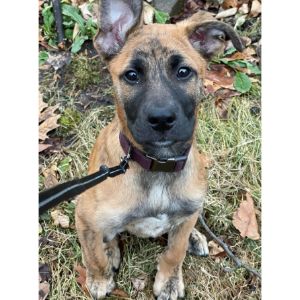
It’s common for mixed-breed dogs like Belgian Malinois and German Shepherds to have inconsistent temperaments. The child’s behavior will be influenced by the parent it is most similar to.
Most Belgian Shepherds share certain characteristics, however. Active and alert, this mix is loyal and alert. The hybrid dog is also known for being energetic and loving.
This hybrid dog is a fairly easy to train, thanks to its German Shepherd background. Just five repetitions are enough to teach the German Malinois mix a trick. These hybrid dogs are intelligent and work well!
As a result, he is sometimes over-excited and tends to be stubborn. For first-time dog owners, this may make them a poor choice.
Besides being a good companion, this dog is also an athlete. Households with modest budgets may find these active dogs too much to handle.
This German Malinois breed is no slouch when it comes to guarding. As with its parent breeds, this dog is confident and protective. These dogs make excellent guard dogs since they bark at strangers and suspicious objects.
Although aggressive and possessing a high prey drive, this hybrid can be unpredictable. Smaller animals will be chased by it. The Malinois X is considered the most suitable pet for a home with only one pet.
Despite their intimidating characteristics, Belgian German Shepherds combine affection, obedience, and docility. Additionally, if trained at a young age, it can be trusted with children and other pets.
Attention is one of the Malinois X’s greatest strengths. Dogs like this one tend to get jealous of other pets. Attention must be paid to the German-Malinois mix! Separation anxiety can also be a problem.
It is a great family and guard dog to own a Belgian Malinois German Shepherd mix. Families with older children will benefit most from them.
Exercise Requirements

Belgian Malinois German Shepherd mixes must be exercised and trained for a long and happy life. These dogs need a lot of exercise and mental stimulation due to their high energy level.
You should walk or run daily, play interactively, and train your dog in structured obedience routines. Destructive or hyperactive behavior may result if they don’t get enough exercise and mental stimulation.
They are recommended for approximately 30 to 60 minutes of moderate exercise a day. Activities such as playing outside, walking, or running in the park could be included. Hyperactive or destructive behavior may result from insufficient exercise.
It is important for working dogs to have jobs to do as they are working dogs.
It is common for Belgian Malinois German shepherd mix owners to enter their dogs in obedience competitions and herding competitions. Also, they make excellent police dogs, guard dogs, and search and rescue dogs.
When a family spends much time outside or doing chores at home.
Belgian Malinois German Shepherd mixes are beautiful dogs that make excellent family pets if trained and exercised properly. A family with the right environment can benefit greatly from these dogs.
Diet Requirements
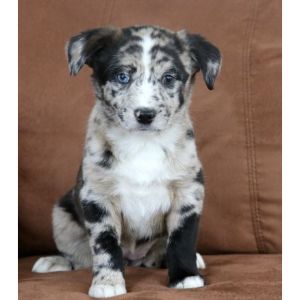
Providing it is fed and nourished properly, the Malinois X requires little maintenance. German Malinois can be properly nourished with high-quality dry dog food. Calcium and protein should be abundant in its kibbles.
An interesting dog breed is the Malinois X, which functions well on a raw diet. However, raw meat can also be given to your dog instead of dry kibble.
German Malinois dogs live an active lifestyle as working dogs. Therefore, this dog consumes three to four cups of food daily and has a fast metabolism.
The German Malinois is a big eater, so free feeding is not a good idea. Dogs that overeat may develop digestive problems or obesity as a result.
Grooming

German Shepherd/Belgian Malinois mixes shed very little for a dog with a dense double coat.
Keeping their coat in good shape usually requires just a weekly brushing. The nails need to be trimmed every few weeks and require baths and ear cleanings.
Belgian malinois german shepherd mixes have dense double layers in their coats that need regular grooming!
It is recommended that, at the very least, brushing should be done every day. They shed a fair amount at all times of the year (though it is more intense around the change of seasons).
The best way to prevent dental disease and tooth decay for pets is to scrape or brush their teeth every day or every week.
Professional groomers should bathe and trim the dog’s nails periodically in order to provide proper foot care. Maintaining healthy ears also requires ear cleaning every 1-2 weeks!
Common Health Problems
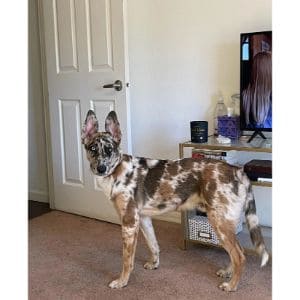
In the Belgian Malinois German Shepherd mix, common health concerns are dysplasia of the hips, elbows, and eyes and diseases similar to distichiasis in which the eyelashes grow inward toward the cornea or another entropion disease.
Additionally, they can develop seizures and stones in their urine, which are common among similar breeds. In terms of basic health care, these dogs are often very manageable thanks to their intelligence and ability to learn commands quickly.
As discussed earlier, a Belgian Malinois-German Shepherd mix is frequently used as a working dog. These people’s high-energy lifestyle and frequent activity may lead to health problems (e.g., arthritis, hip pain).
Keeping dogs away from health problems caused by genetic predispositions can be avoided by asking the breeder for any hereditary diseases the parents may have.
Furthermore, you should ensure that your dog receives adequate exercise and regular checkups so that these conditions will not develop sooner rather than later.
The deterioration of the transmission fibers in the spinal cord characterizes this disorder. As a result, the feet knuckle over, dragging and losing coordination. Your dog may become paralyzed as a result of it.
An esophageal dilation and loss of mobility are symptoms of megaesophagus. Erosive conditions cause the esophagus to become inflamed. Leaving this untreated can lead to death.
Bloat can also be a dangerous problem. A dog who suffers from bloat suffers from a build-up of pressure in his stomach due to a build-up of air. A dog can end up in shock if blood pools in the back area.
It is caused by insufficient production of pancreatic enzymes that assist in the digestion of fats, proteins, and carbohydrates. Endocrine Pancreatic Insufficiency (EPI) is a hereditary condition. German Shepherds often suffer from this condition.
Atrophy of the retina’s photoreceptor cells is one of the effects of Progressive Retinal Atrophy (PRA). Ultimately, the afflicted dog becomes blind as the photoreceptor cells degenerate.
Other Names For The Mix
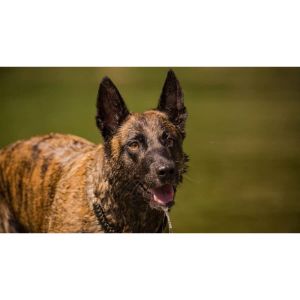
It is not uncommon for Belgian Malinois German Shepherd mixes to be referred to by many different names. German Malinois, German Shepherd Malinois, and Malinois X are all names for these breeds.
It’s because their parents are German Shepherds and Belgian Malinois that they are often referred to as Shepinois. Kennel clubs sometimes give dogs of this breed specific names.
The American Canine Hybrid Club refers to German Malinois as German Hybrids. Design Dog Kennel Club and Designer Breed Registry call it Malinois X.
How Much Do Belgian Malinois Australian Shepherds Mix Cost?

This breed is relatively rare, so you’ll have to shell out a lot of money to own one. The cost of this mix is usually between $1,500 and $2,500. Other factors, including gender, location, and lineage, may influence the price.
Frequently, German Malinois puppies can be found in rescues. The cost would be between $100 and $500 if you found one. Other expenses, such as food, dog supplies, and equipment, are not included in this calculation.
You will also like:
- Should I Get A Male Or Female Belgian Malinois?
- Are Belgian Malinois Aggressive?
- Can Australian Shepherds Hunt?
For more Australian Shepherd Mixes, check out the video below:




